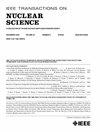电离辐射照射下的原位模拟内存计算
IF 1.9
3区 工程技术
Q3 ENGINEERING, ELECTRICAL & ELECTRONIC
引用次数: 0
摘要
我们实验在电离辐射下进行了原位模拟内存计算(IMC),使用40纳米氧化硅-氮化氧化物-硅(SONOS)电荷阱存储器阵列,其外围电路支持模拟矩阵向量乘法(MVM)运算。SONOS阵列使用模拟mvm处理卷积神经网络(CNN)的最后一层,用于TinyImageNet图像分类,同时受到来自Co-60源的伽马射线的照射。我们通过实验表征了随着总电离剂量(TID)增加至3.2 Mrad(Si),以下数量是如何逐渐退化的:映射到SONOS状态的神经网络权重,由模拟mvm计算的点积,以及由此产生的神经网络图像分类精度。通过多尺度模拟,我们证实了实验观察到的精度损失几乎完全来自于电离辐射在SONOS记忆细胞中引起的状态依赖性电流偏移。实验验证的SONOS模拟计算辐射效应模型可用于指导可靠的空间级模拟IMC加速器的设计。本文章由计算机程序翻译,如有差异,请以英文原文为准。
In Situ Analog In-Memory Computing Under Ionizing Radiation Exposure
We experimentally performed in situ analog in-memory computing (IMC) under ionizing radiation, using a 40-nm silicon-oxide–nitride-oxide–silicon (SONOS) charge-trap memory array with peripheral circuits that support analog matrix-vector multiplication (MVM) operations. The SONOS array used analog MVMs to process the last layer of a convolutional neural network (CNN) for TinyImageNet image classification while being irradiated by gamma rays from a Co-60 source. We experimentally characterized how the following quantities were gradually degraded by increasing the total ionizing dose (TID), up to 3.2 Mrad(Si): neural network weights that were mapped to SONOS states, dot products that were computed by analog MVMs, and the resulting image classification accuracy of the neural network. Using multiscale modeling, we confirmed that the experimentally observed accuracy loss originates almost entirely from the state-dependent current shifts induced by ionizing radiation in the SONOS memory cells. Our experimentally validated model of radiation effects in SONOS analog computing can be used to guide the design of reliable space-grade analog IMC accelerators.
求助全文
通过发布文献求助,成功后即可免费获取论文全文。
去求助
来源期刊

IEEE Transactions on Nuclear Science
工程技术-工程:电子与电气
CiteScore
3.70
自引率
27.80%
发文量
314
审稿时长
6.2 months
期刊介绍:
The IEEE Transactions on Nuclear Science is a publication of the IEEE Nuclear and Plasma Sciences Society. It is viewed as the primary source of technical information in many of the areas it covers. As judged by JCR impact factor, TNS consistently ranks in the top five journals in the category of Nuclear Science & Technology. It has one of the higher immediacy indices, indicating that the information it publishes is viewed as timely, and has a relatively long citation half-life, indicating that the published information also is viewed as valuable for a number of years.
The IEEE Transactions on Nuclear Science is published bimonthly. Its scope includes all aspects of the theory and application of nuclear science and engineering. It focuses on instrumentation for the detection and measurement of ionizing radiation; particle accelerators and their controls; nuclear medicine and its application; effects of radiation on materials, components, and systems; reactor instrumentation and controls; and measurement of radiation in space.
 求助内容:
求助内容: 应助结果提醒方式:
应助结果提醒方式:


